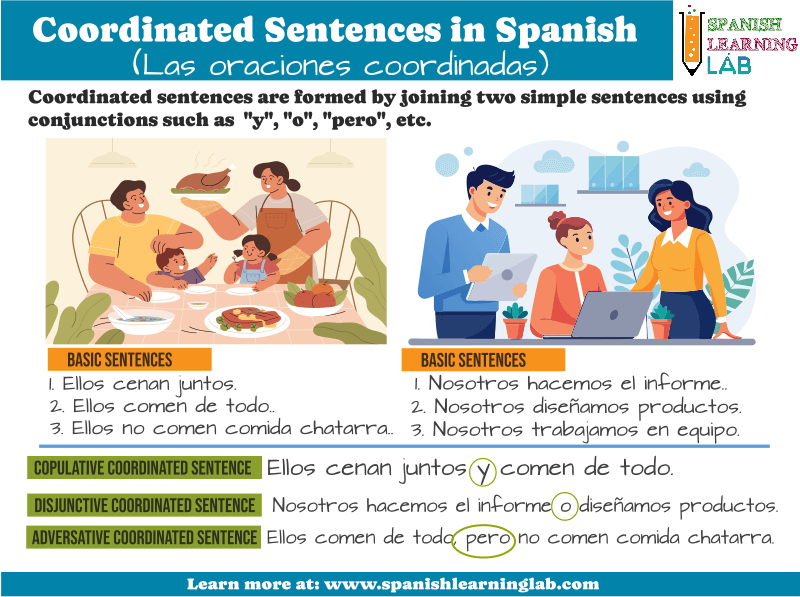Thank you for visiting our site! In this lesson, we will cover the rules to form a special type of compound sentences in Spanish called coordinated sentences or “las oraciones coordinadas“, which are used very frequently in the language. Let’s start…
What are coordinated sentences in Spanish?
First, as we mentioned before, Spanish coordinated sentences are a subset of compound sentences, that is, they are formed by two or more basic sentences. When we refer to basic sentences in the language (oraciones simples), we talk about those with a subject and just a verb, for example: “Yo vivo ahí”. (I live there). We call them coordinated sentences because the sentences that are part of them are connected using coordinating conjunctions such as “y”(and), “o” (or) and “pero”(but). Take a look at these two basic sentences in Spanish:
- Yo tengo varios amigos. (I have several friends)
- Nosotros salimos los fines de semana. (We go out on weekends.)
Both statements are “oraciones simples” because they have a single verb, “TENER” (to have) in the first one and “to go out” in the second one. In this case, it would be easy to form a coordinated sentence by joining both sentences with the conjunction “y” just like this:
- Yo tengo varios amigos y salimos los fines de semana. (I have several friends, and we go out on weekends.)
How are Spanish coordinated sentences classified?
These types of sentences are classified into three distinct groups based on the conjunction that joins or coordinates both sentences. Therefore, we can find three different categories:
- Coordinada copulativa: Nosotros cenamos juntos y fuimos al cine. (We had dinner together and went to the movies)
- Coordinada disyuntiva: ¿Hago el pedido ahorita o espero hasta mañana? (Should I place the order now or wait until tomorrow?)
- Coordinada adversativa: Hemos buscado por todos lados, pero no encontramos nada. (We’ve searched everywhere, but we haven’t found anything.)

Copulative coordinated sentences (las oraciones coordinadas copulativas)
As shown in the examples in the picture above, Spanish copulative coordinated clauses are generally connected with the conjunction “y,” unless the word that follows “y” begins with the vowel “i,” in which case we would replace “y” with the vowel “e.” Pay attention to these examples:
| Los astronautas viajaron a la luna y regresaron una semana después. The astronauts went to the moon and returned a week later. |
| Leonardo da Vinci pintó a la Mona Lisa e inventó varios artefactos fascinantes. Leonardo da Vinci painted the Mona Lisa and invented several fascinating artifacts. |
| Analizaremos los informes y tomaremos una decisión mañana. We will analyze the reports and make a decision tomorrow. |
Online practice:
Drag and drop the conjunctions and basic sentences to the correct boxes to form four copulative coordinated sentences in Spanish.
Disjunctive coordinated sentences (las oraciones coordinadas disyuntivas)
Spanish disjunctive coordinated sentences are used to express or explain two different options, and are generally formed by joining two clauses with the conjunction “o” (or), unless the word immediately after “or” also begins with the vowel “o”, in which case it will be necessary to replace the “o” with “u”, as shown in these sentences:
| ¿Quieres cocinar algo o pasamos comprando algo de comer? Do you want to cook something or should we buy something to eat? |
| ¡Termina de ordenar tu habitación o no tendrás permiso de jugar afuera! Finish cleaning your room or you won’t be allowed to play outside! |
| En su tiempo libre, lee revistas de ciencia u observa las estrellas con su telescopio. In his free time, he reads science magazines and observes the stars with his telescope. |
Online practice:
Drag and drop the conjunctions and simple clauses to the correct spaces to form these disjunctive coordinate clauses in Spanish.
Adversative coordinated sentences (las oraciones coordinadas adversativas)
Spanish adversative coordinated sentences are essential for contrasting two different ideas or opinions with the help of adversative conjunctions such as “pero,” “mas,” and “sino.” The conjunction “mas” doesn’t need a tilde for this purpose, and it is also used formally, rarely in casual conversations. Here are some examples:
| Habíamos estudiado para el examen, pero estaba más difícil de lo esperado. We had studied for the exam, but it was harder than expected. |
| Los rescatistas intentaron sacarlos de los escombros, mas todo fue en vano. Rescuers tried to pull them out of the rubble, but it was all in vain. |
| Esta obra de teatro no es memorable, sino bastante aburrida. This play is not memorable, but rather boring. |
Online practice:
Drag and drop the conjunctions and basic sentences to the correct places to complete these disjunctive coordinated sentences.
